Varanasi
Lying in the south of Uttar Pradesh, on the banks of the holy River Ganga, breathes Varanasi, which is believed to be the the oldest living city in the world. For centuries, the mystic of this place has been attracting pilgrims from across India as well as abroad. A dwelling of ancient domes, muths, ashrams, priests, narrow lanes with shops filled with Benaresi sarees, Varanasi represents the colorful and fascinating India of your dreams. With intimate rituals of life and death being parallelly performed on the Ghats, you’ll find it exhilarating to explore the religious geography of this city. Walk through the busy alleyways or watch the sunrise from a boat for an unforgettable experience. Trace the perimeter of the city, paying homage to shrines all the way. Who knows, a journey to this City of Light may turn out to be your favorite stop of all.
Places to Visit in Varanasi
- Ganges River
- Dasaswamedh Ghat
- Assi Ghat
- Manikarnika Ghat
- Dhamek Stupa
- Shri Kashi Vishwanath Temple
- Banaras Hindu University
- Ruchika Art Gallery
- Shri Durga Temple
- Ramnagar Fort
- Darbhanga Ghat
1.Shri Kashi Vishwanath Temple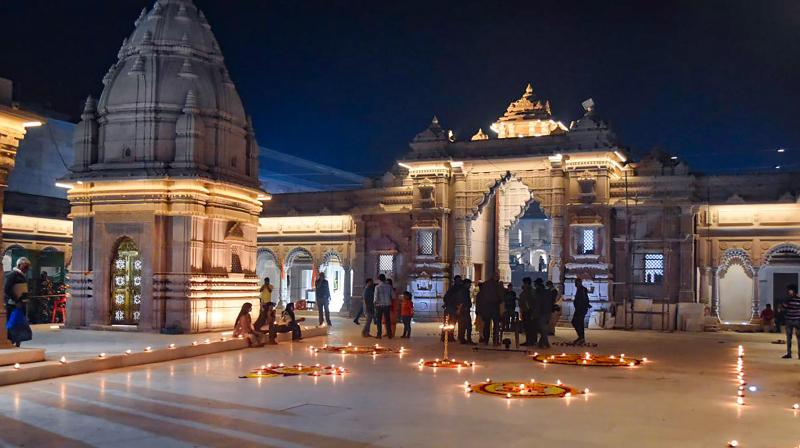
The Kashi Vishwanath temple is one of the most popular temples of Lord Shiva. Standing on the western banks of the holy Ganga, this serene temple is one of the twelve Jyotirlingas and is located amidst the crowded lanes in the holy city of Varanasi. It is believed that Varanasi is the place where the first Jyotirlinga manifested itself. This was that fiery pillar of light which broke from the earth’s crust and flared right to the Heaven. It was through this light that Lord Shiva proclaimed His Supremacy over all the other Gods. Thus, the Kashi Vishwanath temple, also known as the Shri Vishweshwar Temple, is said to be dear to Lord Shiva.
Many Hindus believe that this is the temple where one can achieve salvation. It is here that Lord Shiva gives the Tarak mantra to the ones who are about to die. Pray to the Kashi Vishwanath and all your desires are sure to be fulfilled.
2.Ganges River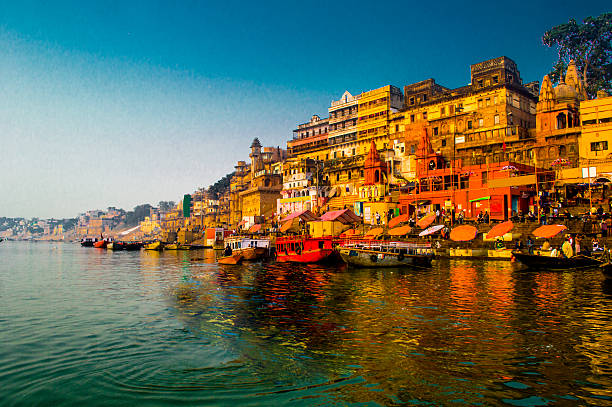
Ganges River, Hindi Ganga, great river of the plains of the northern Indian subcontinent. Although officially as well as popularly called the Ganga in Hindi and in other Indian languages, internationally it is known by its conventional name, the Ganges. From time immemorial it has been the holy river of Hinduism. For most of its course it is a wide and sluggish stream, flowing through one of the most fertile and densely populated regions in the world. Despite its importance, its length of 1,560 miles (2,510 km) is relatively short compared with the other great rivers of Asia or of the world.
Rising in the Himalayas and emptying into the Bay of Bengal, it drains one-fourth of the territory of India, and its basin supports hundreds of millions of people. The greater part of the Indo-Gangetic Plain, across which it flows, is the heartland of the region known as Hindustan and has been the cradle of successive civilizations from the Mauryan empire of Ashoka in the 3rd century BCE to the Mughal Empire, founded in the 16th century.
- Dasaswamedh Ghat
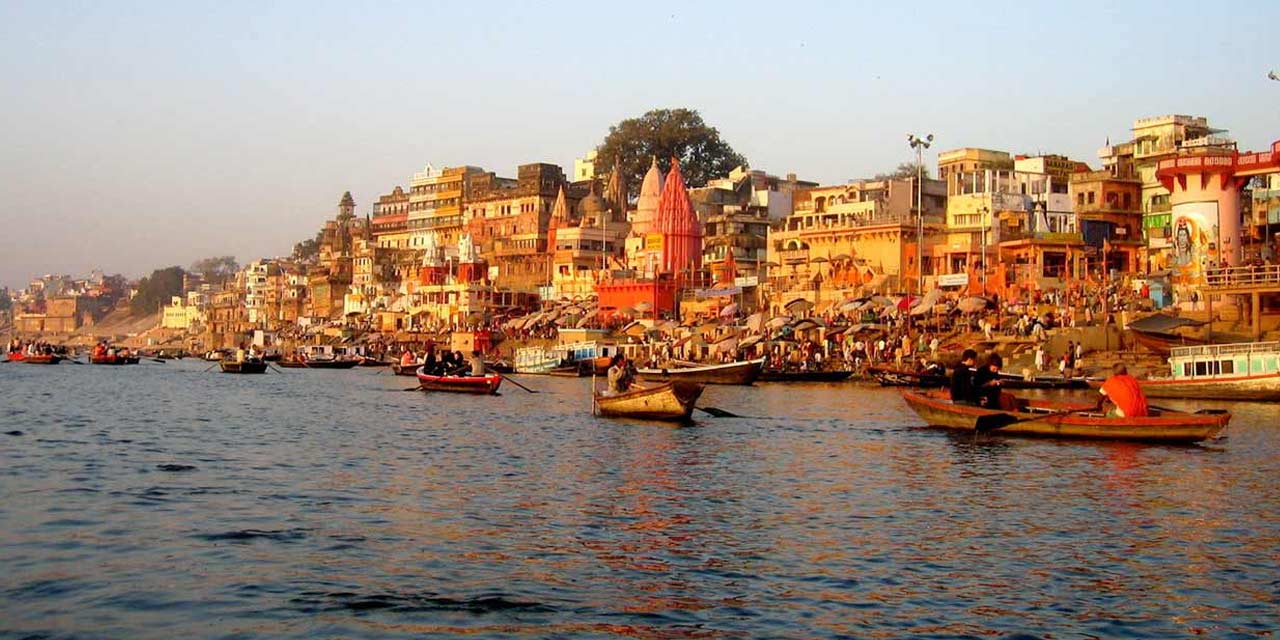
One of the oldest and the most sacred ghats in the holy city of Varanasi is Dashashwamedh. This place is most famous for its Ganga arti ( a holy fire ritual), which is an elaborate and lively ceremony that takes place at dusk everyday. Amid blowing of conch shells, ringing of bells, clanging of brass cymbals and chanting chorus of mantras, priests venerate the Ganga, the lifeline of Varanasi, with brass lamps that rise several tiers. The priests performing the arti are all draped in similar clothing– a kurta and dhoti. The preparations for the arti include collecting five elevated planks, an idol of Goddess Ganga, flowers and incense sticks. Rituals of the arti are performed by those learned in the Vedas and Upanishads and are led by the head priest of the Gangotri Seva Samiti. The arti lasts about 45 minutes. Devotees float smaller diyas on leaf platters in the river as an obeisance to the holy Ganga. As the sunlight recedes, the innumerable lamps flowing in the water make for an unforgettable sight. The hour-long ritual can be watched from the ghat or boats moored at the river bank
The name ‘Dashashwamedh’ means the place where Lord Brahma sacrificed ten horses. It is also said that Bajirao Peshwa I had the ghat reconstructed in 1740 AD. It was later constructed over by the queen of Indore, Ahilyabai Holkar, in 1774. This ghat lies very close to the famous Vishwanath Mandir.
4.Assi Ghat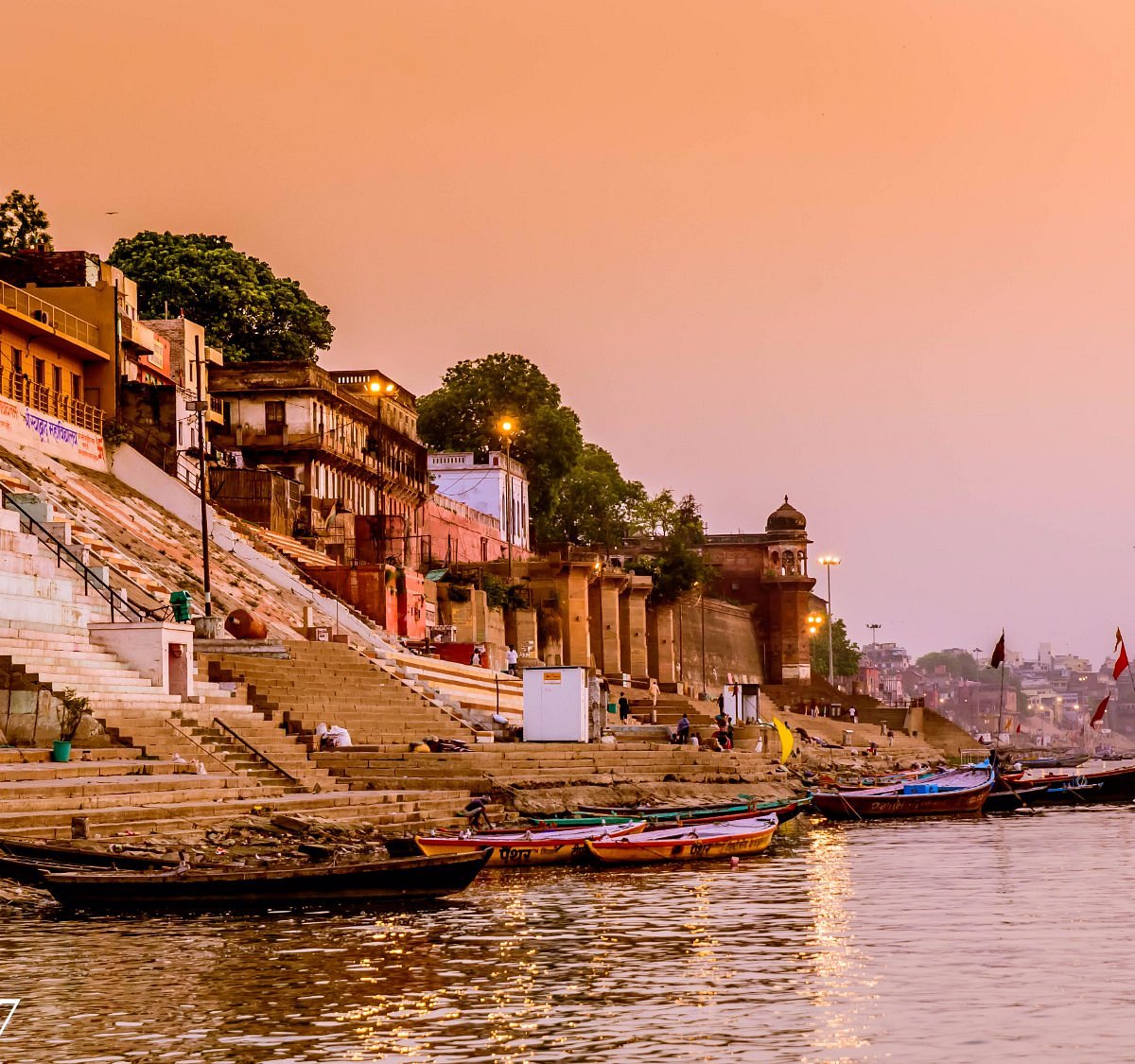
Assi Ghat is one of the most popular ghats in Varanasi, visited regularly by both tourists and locals. It is located in the southern part of the holy city of Varanasi at the confluence of Ganga and Assi rivers. People visit Assi Ghat for several reasons, to soak in the spiritual atmosphere, enjoy the famous evening aarti and get a glimpse into the local culture. This ghat finds a mention in various Hindu scriptures like Kurma Purana, Matsya Purana, Padma Purana and Agni Purana.
Why and how did Assi Ghat get its name? According to a mythological tale in Hinduism, Goddess Durga, after killing the demons Shumbha-Nishumbha, threw her sword. The place where the sword landed, resulted in the emergence of a river which was then called Assi. Another mythological tale states that Lord Rudra (a form of Lord Shiva) was furious with Asuras and eliminated 80 asuras in his rage at this very place. This is how it came to be known as Assi (which means 80 in Hindi). However, after killing the asuras, Lord Rudra repented his actions and wished he hadn’t killed them. Following this incident, he gave up all forms of violence and declared Varanasi as a place which would stand for non-violence.
According to devotees, taking a dip at Assi Ghat (where the two rivers, Ganga and Assi meet) is equivalent to taking a dip at thousands of other holy rivers. There are certain occasions when devotees take a dip by the thousands. Some of these are natural events like lunar and solar eclipse, Makar Sakranti and Probodhoni Ekadashi. There is a Shivlinga under the peepal tree located in the ghat. Here, devotees offer holy water after taking a dip in the Ganga. Another linga can be found inside a small marble temple located in close proximity to the temple.
People visit Assi Ghat, one of the most famous tourist attractions in Varanasi, for various reasons. Some visit it to take a holy dip, others do it to enjoy the peaceful surroundings. Spending some time at the ghat is believed to bring about a calming effect on the mind and body. One of the best times to visit the ghat is during the early morning, when the morning aarti, also called Subeh Benares, is held. Assi Ghat also overflows with visitors during festivals like Mahashivratri and Ganga Mahotsav.
5.Manikarnika Ghat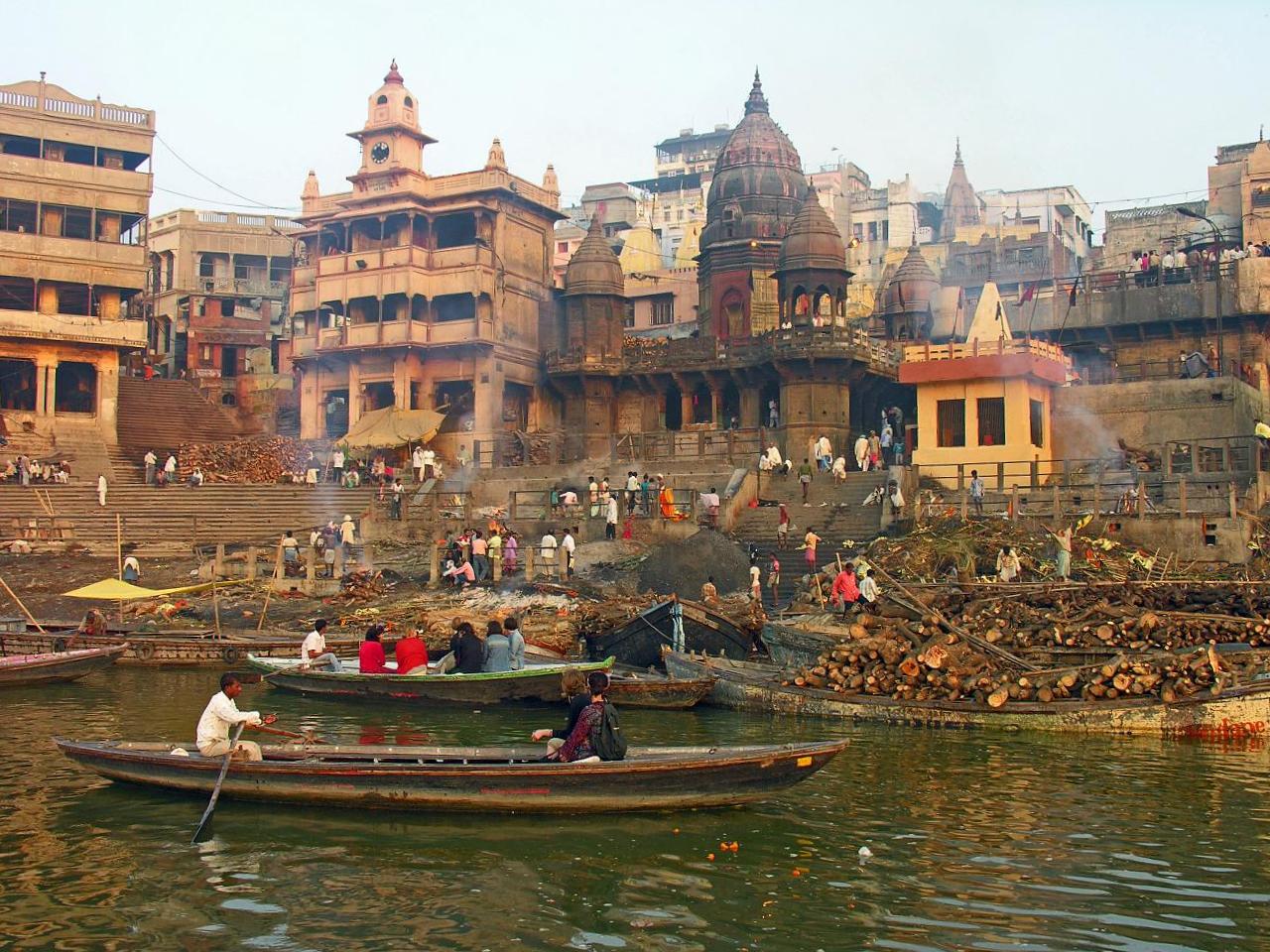
Manikarnika Ghat is one of the oldest ghats in Varanasi and has been accorded the highest position among other ghats by the holy scriptures in Hinduism. It is believed that if a person is cremated here, he immediately attains moksha (salvation). It is bound on both sides by the Scindia Ghat and Dashashwamedh Ghat. Like all the other ghats in Varanasi, the Manikarnika Ghat is surrounded by a fascinating mythological story which also tells us how it acquired its name. It is believed that when Goddess Adi Shakti, or Goddess Sati, jumped into the fire and immolated herself, Lord Shiva carried her burning body to the Himalayas. There, he was immersed in unending sorrow. Lord Vishnu, moved by his plight, sent forth his Divine Chakra (one of his weapons) which cut Goddess Adi Shakti’s body into 51 pieces. Each of the place where her pieces fell on Earth were declared as a Shakti Peeth. Because her earrings fell at this ghat, it was established as a Shakti Peeth and named Manikarnika since Manikarna in Sanskrit means ear rings.
A variety of sights, sounds and smells greet you at the ghat. On one corner, you may see a priest sermonising to a crowd of people, while on the other, your eyes meet people engaged in rites related to cremation. As hundreds of bodies are consigned to the flames, the air is filled with smoke, perhaps reminding an onlooker of the inevitability of death and how temporary everything really is. Although photography is allowed at the Manikarnika Ghat, one of the tourist attractions in Varanasi, care should be taken that there is no interference with the entire process.
6.Dhamek Stupa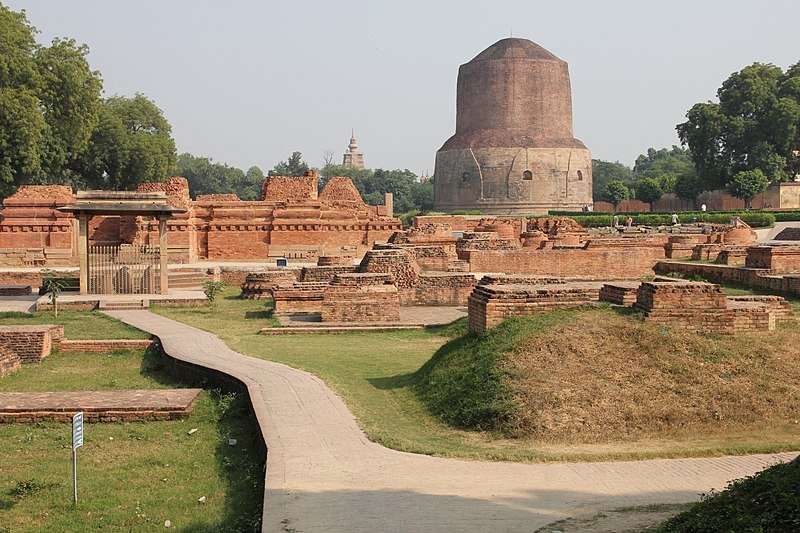
Dhamek Stupa (also spelled Dhamekh and Dhamekha, traced to Sanskrit version Dharmarajika Stupa, which can be translated as the Stupa of the reign of Dharma) is a massive stupa located at Sarnath, 13 km away from Varanasi in the state of Uttar Pradesh, India.
Stupas originated as pre-Buddhist tumuli, in which ascetics were buried in a seated position, called chaitya. After the parinirvana of the Buddha, his remains were cremated and the ashes divided and buried under eight mounds with two further mounds encasing the urn and the embers. Little is known about these early stupas, particularly since it has not been possible to identify the original ten monuments. However, some later stupas, such as at Sarnath and Sanchi, seem to be embellishments of earlier mounds. The Dhamek Stupa was built in 500 CE to replace an earlier structure commissioned by the great Mauryan king Ashoka in 249 BCE, along with several other monuments, to commemorate the Buddha’s activities in this location. Stupas originated as circular mounds encircled by large stones. King Ashoka built stupas to enshrine small pieces of calcinated bone and other relics of the Buddha and his disciples.An Ashoka pillar with an edict engraved on it stands near the site.
The Dhamek Stupa is said to mark the spot (Rishipattana which can be translated as “where the Rishi arrived”) where the Buddha gave the first sermon to his first five disciples, led by Kaundinya, after attaining enlightenment, “revealing his Eightfold Path leading to nirvana”. This event marked the formation of the sangha. In several of the ancient sources the site of the first sermon is mentioned to have been at a ″Mriga-dayaa-vanam″ or a sanctuary for animals. ( In Sanskrit mriga is used in the sense of game animals, deer being the most common). The last royal endowment at the site is dated to about 12th c. CE, after which the location of the Mrigadayavanam seems to have been lost even to the devout. The stupa was enlarged on six occasions but the upper part is still unfinished. While visiting Sarnath in 640 CE, Xuanzang recorded that the colony had over 1,500 priests and the main stupa was nearly 300 feet (91 m) high.
In its current shape, the stupa is a solid cylinder of bricks and stone reaching a height of 43.6 meters and having a diameter of 28 meters. It is the most massive structure in Sarnath. The basement seems to have survived from Ashoka’s structure: the stone facing is chiseled and displays delicate floral carvings of Gupta origin. The wall is covered with exquisitely carved figures of humans and birds, as well as inscriptions in the Brāhmī script.
7.Ruchika Art Gallery
Probably, the most ideal place that proffers you a chance to give your home a touch of Varanasi art is Ruchika Art Gallery. Founded by a local lady, Ruchika, this renowned art gallery in Varanasi is one of the best places in the city to adore contemporary art. While exploring this art gallery, tourists can often be seen purchasing a few paintings of their interests. On display, you can find an array of contemporary modern art that are astonishing in themselves. Besides, various local university art programs are also organized at Ruchika Art Gallery. This popular tourist site in Varanasi also offers painting courses for tourists. On the whole, it is one of the perfect places to satiate your urge of exploring the local art.
8.Shri Durga Temple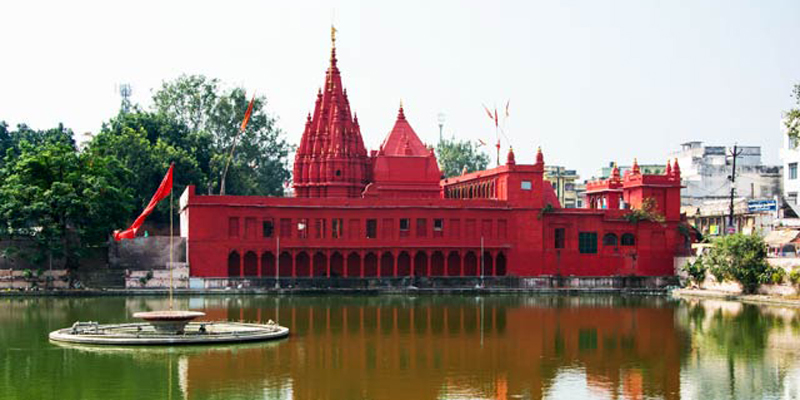
Durga temple is also known as the Monkey temple (because of the presence of huge number of monkeys), situated in the Durga Kund, Varanasi. The temple is dedicated to the Goddess Durga. It was built in the 18th century. Durga temple was constructed by a Bengali Maharani in the north Indian Style with multi tiered shikhara. An attractive pond known as the Durga Kund is made on the right side of the temple which really increases the beauty of the temple. The pond has stone stairs at all sides as well as there is watch pillars at each corner of the pond.
The statue of Goddess Durga is not human made; it was appeared by its own in the temple. A millions of Hindu devotees go to the Durga temple in the Navratri and other propitious occasions and pray to the Goddess Durga to complete their wishes. This temple is made up in the square shape with the red color stone representing the color of the Mata Durga. Some of the devotees make a round around the building of the temple for their religious importance he Hinduism. It is considered that Durga Mata always protects the Varanasi from problems.
In the Hinduism, it is considered that Mata Durga is the incarnation of the Shakti (Parvati, the consort of Lord Shiva) means female power. Mata Durga is dressed in red color having ride on a tiger and entirely equipped with the Shiva’s trident, Vishnu’s discus, sword etc.
Another Durga temple, known as the Brahmacharini Durga Temple is situated close to the Durga Ghat (means Durga Kund) at the bank of the holy river Gange in Varanasi. Durga Ghat is one of the most famous Ghat in the Varanasi was built in 1772 by a saint, Narayana Diksit.
9.Ramnagar Fort
Ramnagar Fort is located on the eastern bank of River Ganges, opposite to Tulsi Ghat, in Varanasi. The 18th-century red sandstone fort was built in Mughal style by the ruler of Kashi, Maharaja Balwant Singh. It is said to be the ancestral home of the Maharaja of Banaras. A 30-minute boat ride away from Varanasi, the fort is an imposing sight, rising from the bank of the river. It houses a temple dedicated to Ved Vyasa, the author of the Mahabharata, along with a popular temple dedicated to Lord Hanuman. A museum inside the compound showcases collectables belonging to the royal family. It is known for its exhibits of antique scripts and scriptures, vintage furniture, cars, royal costumes, gold and silver brocaded palanquins and elephant saddles carved out of silver. There is an armoury that contains swords and old guns from Burma (Myanmar), Japan and some African countries, and a rare astronomical clock, which shows the month, week, day, time and other astronomical details about the position of planets, moon and sun. The clock was built in the 19th century in the court of a king of Varanasi. It is said that Ved Vyasa lived and did penance in Ramnagar and thus the fort was built in his honour. The fort palace appears most vibrant during the one-month-long Ram Leela festival held in the months of October-November, where scenes from the epic Ramayana are enacted.
10.Darbhanga Ghat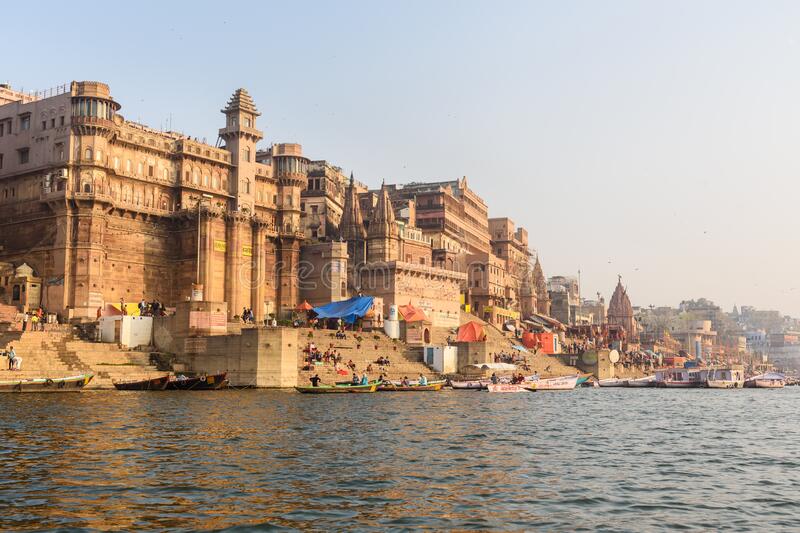
Located between the Dashaswamedh Ghat and the Rana Mahal Ghat, Darbhanga Ghat was named after the royal family from Darbhanga. Apart from the ghat, the family also built a magnificent palace in 1900s near the bank of the river from where they could watch the rituals and other activities. Popular Hindu belief has it that dying or being cremated on the ghats of Varanasi is a path to salvation. Like most ghats, Darbhanga Ghat also serves as an open crematorium. The ghat is a bit steep and narrow but becomes wide near Babua Pandey Ghat. This ghat also has a temple dedicated to Lord Shiva.
Things to Do
1.Witness Grandeur Evening Aarti Ceremony
2.Morning Boat Ride in Ganges River
3.Explore Varanasi Temples
4.Take a Holy Bath in Ganges
5.Stroll Along the Ghats
6.Go for a Sightseeing Tour of Sarnath
7.Shopping in Varanasi’s Local Market
8.Visit Historical Ramnagar Fort
9.Visit Dashashwamedh Ghat
10.Savour Local Street Food
11.Have Lassi at Blue Lassi Cafe
12.Visit Weaver’s Village
13.Visit Jantar Mantar
14.Ramayana Lesson at Tulsi Manas Temple
15.Try Bhang from Godowlia
Interesting facts about Varanasi
1.The most ancient surviving city
2.The epicenter of sciences
3.A major trading center
4.A hub of rich literature
5.A religious hub
6.Banaras Hindu University (BHU)
7.A favourite site for shooting
8.A source of music
9.A rich cultural milieu
10.Frog Marriage
Importance
The land of Varanasi (Kashi) has been the ultimate pilgrimage spot for Hindus for ages. Hindus believe that one who is graced to die on the land of Varanasi would attain salvation and freedom from the cycle of birth and re-birth. Abode of Lord Shiva and Parvati, the origins of Varanasi are yet unknown.
Best Time to Visit In Varanasi
The best time to visit Varanasi is during the winter months (November to February). Although it gets fairly cold during the winters, this is the best time when you can explore the holy city without getting tired. The average low temperature is around 5°C.